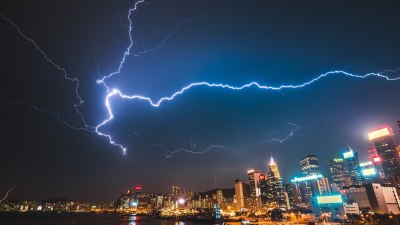Why Nature’s Thermostat Is Always Broken and Set to 'Surprise'
Explore how nature's unpredictable climate impacts ecosystems and humanity alike, revealing insights into our future.

This image was created with the assistance of Freepik
Nature's thermostat, a term often used to describe the delicate balance of Earth's climate, seems to be perpetually malfunctioning. Whether it's unprecedented heatwaves or unseasonal snowfall, the patterns we once took for granted now appear to be tinged with surprise and unpredictability. Understanding why this is happening requires diving deeper into the mechanisms that govern our climate and the anthropogenic factors exacerbating these natural systems.
The Climate System: A Complex Web
Earth's climate is a composite of numerous interconnected systems. Factors such as solar radiation, atmospheric composition, ocean currents, and terrestrial ecosystems work in concert to maintain a relatively stable climate. However, this stability is under constant threat from both natural variations and human activities. Volcanic eruptions can spew ash and gases into the atmosphere, temporarily cooling temperatures, while phenomena like El Niño can lead to significant alterations in weather patterns.
The Role of Greenhouse Gases
Human activities have intensified the greenhouse effect, primarily through the burning of fossil fuels and deforestation. This addition of greenhouse gases such as carbon dioxide and methane to the atmosphere traps more heat from the sun, escalating global temperatures. The Intergovernmental Panel on Climate Change (IPCC) has warned that these changes induce more extreme weather events, melting ice caps, rising sea levels, and disrupted ecosystems.
Feedback Loops: Amplifying the Change
The climate system operates through various feedback loops that can either amplify or dampen changes. For instance, as the polar ice melts, less sunlight is reflected back into space, leading to further warming and more ice loss. Similarly, thawing permafrost releases trapped methane, a potent greenhouse gas, further exacerbating global warming. These feedback mechanisms contribute to the sense that nature's thermostat is always 'surprised', as forecasts can quickly become outdated.
Extreme Weather Events
Weather events once categorized as rare have now become commonplace as global temperatures rise. Heatwaves affecting large swathes of the United States during summer months can lead to catastrophic wildfires, while other regions may face unprecedented flooding from torrential rains. Such events not only damage ecosystems but also disrupt human livelihoods and health, highlighting the urgent need for adaptation and mitigation strategies.
Impact on Ecosystems
In the wake of these surprising changes, ecosystems and the species that inhabit them are often left vulnerable. Species can become extinct if they are unable to adapt quickly enough to the changing conditions. Coral reefs, for instance, are experiencing widespread bleaching as ocean temperatures rise, jeopardizing marine biodiversity. Terrestrial habitats are not immune either; shifting climates force many animals to migrate to cooler areas, often leading to competition for resources and habitat loss.
The Human Factor
While nature's thermostat may appear broken, a significant part of the unpredictability stems from human actions. Urbanization, pollution, and unsustainable agricultural practices contribute to local and global climate shifts. Cities are often hotter than rural areas due to the heat island effect, leading to increased energy consumption for cooling. This exacerbates the problem, creating a cyclical pattern of increasing temperatures and escalating demand for energy.
Reassessing Our Relationship with Nature
The current state of nature's thermostat necessitates a reevaluation of our relationship with the environment. Sustainable practices can help mitigate some of the damage caused by climate change, such as transitioning to renewable energy sources and adopting conservation methods. By restoring ecosystems, we can bolster nature's resilience, ultimately leading to more stable climate conditions.
Technological Innovations
Innovation also plays a critical role in addressing climate change. Advances in carbon capture technology aim to reduce the amount of greenhouse gases released into the atmosphere. Additionally, predictive models enhanced by artificial intelligence can help us better understand and respond to climate dynamics. These technologies can also assist in preparing for the unexpected nature of weather patterns, enabling faster responses to extreme events.
Global Cooperation is Key
To navigate the challenges posed by climate change, global cooperation is essential. Initiatives like the Paris Agreement represent international efforts to limit global warming and foster a sustainable future. Such collaboration highlights the collective responsibility we share in protecting our planet from further harm. By working together, nations can implement policies and strategies that not only aim to reduce emissions but also foster resilient ecosystems.
What Lies Ahead?
As we move further into the 21st century, the question of whether nature's thermostat can be fixed or if it's destined to surprise us further remains open. Climate science is advancing rapidly, yet the solutions may require substantial societal changes. Engaging individuals at the local level through education can inspire actions that collectively impact global trends. Understanding and adapting to changes in our environment is not just the responsibility of governments but requires active participation from all sectors of society.
In summary, nature's thermostat might seem broken, but its apparent chaos arises from a complex interplay of natural processes and human intervention. Our future will depend significantly on how we respond to these challenges. Embracing sustainable practices, investing in technology, and prioritizing global cooperation can offer pathways to a more stable climate. Ultimately, while surprises may continue to shape nature's narrative, our proactive choices can help steer our planet towards a more balanced and predictable future.











